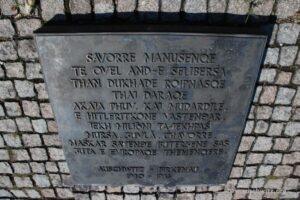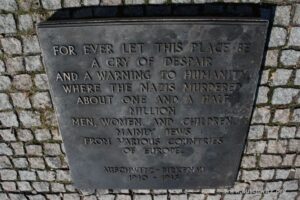“The gypsies, who knew what was in store for them, screamed: fights broke out, shots went off and people were wounded. SS reinforcements arrived when the trucks were only half full. The gypsies even used loaves of bread as missiles. But the SS were too strong, too experienced, too numerous.”
— Dazlo Tilany
Under the rule of Adolf Hitler, the Roma were persecuted, interned and executed as part of the Holocaust. They call it ‘Porajmos’, which means ‘Destruction’ or ‘Devouring’. Estimates of Roma deaths in World War II range from 200,000 to over 1 million.
Roma, along with the Jews, were stripped of their citizenship and denied franchise rights under extensions to the Nuremberg Laws. As early as 1936, the Roma were transferred out of cities to internment camps and ghettos and there was debate within the Nazi government about how to solve the “Gypsy Question.”
In January 1942 at the Wannsee Conference, the “Final Solution” to the “Jewish Problem” was instigated and millions of Jews were systematically exterminated. In December 1942, Himmler ordered the deportation of German and Austrian Roma to Auschwitz-Birkenau as candidates for extermination.
In the extermination camp at Auschwitz II-Birkenau, section Blle was known as the ‘zigeunerlager’, or Gypsy Camp. Men, women and children were imprisoned together, forced into slave labor and tortured. Josef Mengele took a particular interest in the Roma and made them the subject of horrific experiments. Disease was rife.
The Nazis planned to murder the 6000 Roma occupants of the zigeunerlager on May 16th, 1944. The resistance movement in the camp warned the Roma of the plan and in the morning of May 16th, the Roma prisoners refused to report for roll call and ceased cooperating with the German SS.
They barricaded themselves into buildings, armed with hammers, pickaxes and stolen shovels. They made wooden stakes with the slats of their beds and the children collected rocks. The SS arrived in the afternoon to take 6000 people to the gas chambers- but they were met with fierce resistance.
The SS had not anticipated the resistance and sustained losses in the fight. Fearful of the resistance spreading across the rest of Auschwitz, the SS retreated. The camp was placed on a harsh starvation diet.
A week later, the Nazis removed 1500 of the strongest Roma to Auschwitz I and Buchenwald. Two days later, more Roma men and women were removed to Ravensbruck and Flossenburg. Less than 3000 prisoners remained in the zigeunerlager- many of them children.
In the middle of the night on August 2nd, the SS returned. They faced resistance and needed reinforcements but eventually 2,897 Roma were loaded onto trucks, taken to gas chamber V and exterminated. Their bodies were burned in pits next to the crematorium. In total, 23,000 Roma died in Auschwitz-Birkenau.
The current rise of far right political parties and alliances in Europe is a cause for concern for the 10 million Roma on the continent. The marked increase in support for the Jobbik party in Hungary’s 2014 general election is indicative of a broader danger for minority groups. Jobbik leader Gábor Vona has expressed his concerns that the Hungarian population ‘is falling while the gypsy population increases’, despite the fact that Roma account for only 3.16% of the population according to the 2011 Hungarian census. In addition, violence against Roma has increased in Hungary, with six Roma murdered in a string of attacks in 2008 and 2009. Almost 300 Roma were evacuated from Gyongyospata by the Red Cross in 2011 because of rising fear of attacks by vigilante group Vedero.
The Roma experience of the Holocaust is not widely known or accepted- even among the Roma themselves. Until 1982, the West German government insisted that Roma were imprisoned for their asocial characteristics and not because of racial discrimination. It’s important to show the truth of the Roma struggle against a backdrop of escalating racism, prejudice and discrimination against the community internationally.
[ezcol_1half]
 [/ezcol_1half] [ezcol_1half_end]
[/ezcol_1half] [ezcol_1half_end] [/ezcol_1half_end]
[/ezcol_1half_end]
Roma and English translations of the International Memorial at Auschwitz today.
